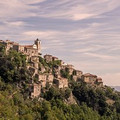的点评
From Labyrinth to Amazing Views. From Medieval to Modern.
Šmartno的点评
点评:In this area of alpine meadows, vineyards dominate the landscape. In every direction, grapevines carefully hug fields as far as the eye can see, dropping behind the horizon.
I first saw Smartno’s fortified Medieval village (called an eagle’s nest by poet A. Gradnik) from the Gonjace viewing tower a stone throw from there. To view this hamlet within the context of all those meadows, vineyards, cherry orchards, figs and olive groves is breathtaking.
For many travelers, these gentle, rolling hills reminds them of Tuscany. The region and its wineries are famous for their hospitality, and are yet to be discovered but that won’t last much longer. There are more than 150 wine producers in the region. Take your pick!
The village on the top of a hill, surrounded by defense walls with watchtowers is first mentioned in 1317. There are no historical records of the origin of the defense walls, but it is believed that the walls were probably erected on the remains of a Roman bastion in the period of the wars between the Habsburgs and the Venetians during 1507-1519.
Šmartno, served as a fortified hamlet, built around the church of St. Martin, during the times of the Turkish raids in the 15th and 16th century. It became a strategically important point on the border between Venice and Austria. Šmartno was actually a part of a larger system of fortifications, which included other villages. Šmartno was used as a fortification until the middle of the 18th century when danger of military attacks from the Venetians ceased.
Walking this small village takes a mere 30-45 minutes and it feels like you are in a labyrinth of sort with only two ways out. One can’t get lost as it is a very small place.
In the pre-Roman period, wine-growing began in this area because of the excellent weather, unique climate, which has both powerful Alpine and mild Mediterranean influences, as well as mineral and rich soil. It was an established wine-growing area as far back as 181 BCE. Many ancient amphoras found in this area show how vital the village and its environment were as a place where wine was grown. Yet it is little known.
In the village you can also enjoy wine tasting, good restaurant, a few homemade jams, honey, etc.
See this wonderful place for yourself.
I first saw Smartno’s fortified Medieval village (called an eagle’s nest by poet A. Gradnik) from the Gonjace viewing tower a stone throw from there. To view this hamlet within the context of all those meadows, vineyards, cherry orchards, figs and olive groves is breathtaking.
For many travelers, these gentle, rolling hills reminds them of Tuscany. The region and its wineries are famous for their hospitality, and are yet to be discovered but that won’t last much longer. There are more than 150 wine producers in the region. Take your pick!
The village on the top of a hill, surrounded by defense walls with watchtowers is first mentioned in 1317. There are no historical records of the origin of the defense walls, but it is believed that the walls were probably erected on the remains of a Roman bastion in the period of the wars between the Habsburgs and the Venetians during 1507-1519.
Šmartno, served as a fortified hamlet, built around the church of St. Martin, during the times of the Turkish raids in the 15th and 16th century. It became a strategically important point on the border between Venice and Austria. Šmartno was actually a part of a larger system of fortifications, which included other villages. Šmartno was used as a fortification until the middle of the 18th century when danger of military attacks from the Venetians ceased.
Walking this small village takes a mere 30-45 minutes and it feels like you are in a labyrinth of sort with only two ways out. One can’t get lost as it is a very small place.
In the pre-Roman period, wine-growing began in this area because of the excellent weather, unique climate, which has both powerful Alpine and mild Mediterranean influences, as well as mineral and rich soil. It was an established wine-growing area as far back as 181 BCE. Many ancient amphoras found in this area show how vital the village and its environment were as a place where wine was grown. Yet it is little known.
In the village you can also enjoy wine tasting, good restaurant, a few homemade jams, honey, etc.
See this wonderful place for yourself.
翻译:在这个高山草甸地区,葡萄园占据着主导地位。从各个方向看,葡萄藤小心翼翼地拥抱着田野,一望无际,一直延伸到地平线后面。
我第一次看到斯玛特诺坚固的中世纪村庄(诗人 A. Gradnik 称之为鹰巢)是在距那里一箭之遥的冈贾斯观景塔上。在草地、葡萄园、樱桃园、无花果园和橄榄园的背景下欣赏这个小村庄真是令人叹为观止。
对于许多旅行者来说,这些平缓、连绵起伏的山丘让他们想起托斯卡纳。该地区及其酿酒厂以其热情好客而闻名,虽然尚未被发现,但这种情况不会持续太久。该地区有超过 150 家葡萄酒生产商。任你挑选!
这座位于山顶的村庄,周围环绕着带有瞭望塔的防御墙,最早于 1317 年被提及。关于防御墙的起源,没有历史记录,但据信,这些城墙可能是建在一个罗马人的遗骸上。 1507 年至 1519 年哈布斯堡王朝与威尼斯人之间战争期间的堡垒。
斯马特诺 (Šmartno) 是一个坚固的小村庄,在 15 世纪和 16 世纪土耳其袭击期间围绕圣马丁教堂建造。它成为威尼斯和奥地利边界上的战略要地。斯马特诺实际上是一个更大的防御工事系统的一部分,其中还包括其他村庄。斯马特诺一直被用作防御工事,直到 18 世纪中叶威尼斯人军事攻击的危险消失为止。
步行这个小村庄只需 30 至 45 分钟,感觉就像身处迷宫,只有两条出路。人们不会迷路,因为这是一个很小的地方。
在前罗马时期,由于这里气候宜人,气候独特,既有强烈的阿尔卑斯山气候,又有温和的地中海气候,以及矿物质和肥沃的土壤,这里就开始了葡萄种植。早在公元前 181 年,这里就是一个成熟的葡萄酒产区。该地区发现的许多古代双耳细颈瓶表明,这个村庄及其环境作为葡萄酒种植地有多么重要。但它却鲜为人知。
在村子里您还可以品尝葡萄酒,品尝不错的餐厅,品尝一些自制的果酱、蜂蜜等。
亲自看看这个美妙的地方。
我第一次看到斯玛特诺坚固的中世纪村庄(诗人 A. Gradnik 称之为鹰巢)是在距那里一箭之遥的冈贾斯观景塔上。在草地、葡萄园、樱桃园、无花果园和橄榄园的背景下欣赏这个小村庄真是令人叹为观止。
对于许多旅行者来说,这些平缓、连绵起伏的山丘让他们想起托斯卡纳。该地区及其酿酒厂以其热情好客而闻名,虽然尚未被发现,但这种情况不会持续太久。该地区有超过 150 家葡萄酒生产商。任你挑选!
这座位于山顶的村庄,周围环绕着带有瞭望塔的防御墙,最早于 1317 年被提及。关于防御墙的起源,没有历史记录,但据信,这些城墙可能是建在一个罗马人的遗骸上。 1507 年至 1519 年哈布斯堡王朝与威尼斯人之间战争期间的堡垒。
斯马特诺 (Šmartno) 是一个坚固的小村庄,在 15 世纪和 16 世纪土耳其袭击期间围绕圣马丁教堂建造。它成为威尼斯和奥地利边界上的战略要地。斯马特诺实际上是一个更大的防御工事系统的一部分,其中还包括其他村庄。斯马特诺一直被用作防御工事,直到 18 世纪中叶威尼斯人军事攻击的危险消失为止。
步行这个小村庄只需 30 至 45 分钟,感觉就像身处迷宫,只有两条出路。人们不会迷路,因为这是一个很小的地方。
在前罗马时期,由于这里气候宜人,气候独特,既有强烈的阿尔卑斯山气候,又有温和的地中海气候,以及矿物质和肥沃的土壤,这里就开始了葡萄种植。早在公元前 181 年,这里就是一个成熟的葡萄酒产区。该地区发现的许多古代双耳细颈瓶表明,这个村庄及其环境作为葡萄酒种植地有多么重要。但它却鲜为人知。
在村子里您还可以品尝葡萄酒,品尝不错的餐厅,品尝一些自制的果酱、蜂蜜等。
亲自看看这个美妙的地方。
此点评仅代表旅行者个人的主观意见,并不代表TripAdvisor以及其合作方的意见。
关于我们
|
新闻动态
|
商务合作
|
会员中心
|
业主中心
|
业主通
|
常见问题
|
意见反馈
|
联系我们
|
营业执照
© 2025 Tripadvisor 版权所有。
使用条款 |隐私政策 |网站工作原理
部分照片由 VFM Leonardo 提供。
* Tripadvisor不是旅行社,也不是旅游预订服务代理商。我们提供免费、客观、公正的旅游资讯服务。 (显示更多)
TripAdvisor LLC 既不是预订代理商,也不是旅游运营商,不会向网站用户收取任何服务费。 按照规定,在 Tripadvisor 发布机票价格、游览和旅行套餐的合作伙伴(航空公司、旅行提供商及预订代理商),其标价须包含所有费用和附加费用。 例如, 机场出入境税费、消费税与其他服务费、手续费、杂费及附加费用。 当您向我们的某个合作伙伴进行预订时,请务必查阅他们的网站以了解当地行政部门要求的所有适用费用的具体情况。 除非另有说明,机票价格通常指的是一个人的价格(以人民币计)。
为方便起见,TripAdvisor LLC 根据从我们的预订合作伙伴获取的空房率计算每个酒店的均价。 对于游览和景点来说,所显示价格通常是每位成人的最低可用价格。 对于列出的任何旅行套餐或优惠,TripAdvisor LLC 无法保证任何特定的费率或价格。 此外,酒店均价每晚会更新,并以您的首选币种表示(使用现行汇率)。 由于这些已换算的价格是预估价格,因此,有关具体金额和币种请与预订网站进行核实。
此外,TripAdvisor LLC 无法保证我们网站上宣传的价格随时有效。 标价可能需要预订一定天数才能生效,或有不可用日期、使用条件或限制。
TripAdvisor公司对外部网站的内容一概不负责。优惠价格中不含税和其他费用。
ICP证:沪B2-20200433
沪ICP备20013175号
 沪公网安备31010502005427号
沪公网安备31010502005427号鹰程信息技术(上海)有限公司
货币/国家及地区
¥CNY
中国

